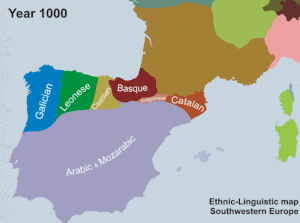Asturleonese language
The name of the language is largely uncommon among its native speakers, as it forms a dialect continuum of mutually intelligible varieties and therefore it is primarily referred to by various regional glossonyms like Leonese, Cantabrian, Asturian or Mirandese (in Portugal).[3] Phylogenetically, Asturleonese belongs to the West Iberian branch of the Romance languages that gradually developed from Vulgar Latin in the old Kingdom of León.The adoption of Latin by the Astures, who inhabited the area, was a slow but inevitable process, as the use of the colonial language was the key to obtaining equal rights; the most important priority, at the time, being to earn Roman citizenship.[clarification needed] During this time, Spanish thrived as a language of prestige and culture, which led to its progressively replacing Asturleonese in these areas, as well as with Galician in neighboring Galicia, leaving it to mainly oral usage.[16] Asturleonese only recently received recognition in the municipality of Miranda do Douro by virtue of Portuguese law 7/99 on 29 January 1999, although merely as a language that should continue to be protected and preserved, not awarding it any official status.In article 3.3 of the constitution, the document concretely states that "the richness of the distinct linguistic modalities of Spain is a cultural heritage that will be the subject of special respect and protection."However, the language is not just the sum of Asturian, Leonese, Zamorano, and Mirandan dialects; in purely linguistic terms, the main divisions of Asturleonese have north-south boundaries and form three separate sections that are shared between Asturias and Leon: occidental, central, and oriental.[25][26][27][28] Given the low social and political acceptance of referring to the language in Asturias as Leonese, and in other parts of the domain (such as León or Zamora) as Asturian (even though it is virtually the same language), a significant part of the authors and specialists prefer to refer to all the dialects collectively as Asturllionés or Asturleonés, although others continue to use the regional terms (like Leonese, Asturian, Mirandese, etc.).At the end of the 20th century, the Academia de la Llingua Asturiana undertook initiatives designed to provide the language with most of the tools needed to survive in the modern era: a grammar, a dictionary and periodicals.In spite of all these difficulties, the number of young people learning and using Leonese (mainly as a written language) has increased substantially in recent years.There is no known, exact number of Asturleonese speakers, as not enough statistical research has been conducted in this area and many dialects are not accounted for due to their close similarities with Spanish.


AsturiasCastile and LeónTierra de MirandaCantabriaExtremaduraLinguistic classificationIndo-EuropeanItalicLatino-FaliscanRomanceItalo-WesternWesternIbero-RomanceWest IberianAsturianLeoneseMirandeseExtremaduranCantabrianISO 639-2ISO 639-3GlottologUNESCOAtlas of the World's Languages in DangerRomance languagePortugalhistorical regionsautonomous communitiesRiudenoredialect continuumreplacedWest Iberian branchVulgar LatinKingdom of LeónCantabrian MontañesSpanishbasilectCastilian SpanishRamón Menéndez Pidalearliest distinguishable formCastilianAragoneseAsturica AugustaRoman Sixth (Hispanian) LegionAsturesCantabrian WarsdiglossicGalicianMiranda do DouroCatalanBasqueSpanish ConstitutionAsturian Statute of AutonomyAssembly of the RepublicPortugueseJosé Leite de VasconcelosGalaicoportugueseZamoraAsturian languageAcademia de la Llingua AsturianagrammardictionaryperiodicalsLeonese languageCastilian languageSalamancaMirandese languageAnstituto de la Lhéngua MirandesaWayback MachineYouTubePrincipality of AsturiasMikroglottikaRomance languagesclassificationEasternItalo-DalmatianSouthernAromanianIstro-RomanianMegleno-RomanianDaco-RomaniandialectsBukovinianCrișanaMaramureșMoldavianOltenianTransylvanianWallachianCentral ItalianCentral MarchigianoCentral−Northern LatianRomanescoSabinoCorsicanGallureseItalianItalo-AustralianMaltese ItalianRegional ItalianSwiss ItalianSassareseTuscanFlorentineExtreme Southern ItalianSalentinoMandurianoSicilianPantescoNeapolitanBareseBeneventoCastelmezzanoCilentanIrpinianArianeseMolisanSouthern LatianTarantinoVasteseDalmatianIstriotJudeo-ItalianGallo-ItalicEmilian–RomagnolEmilian